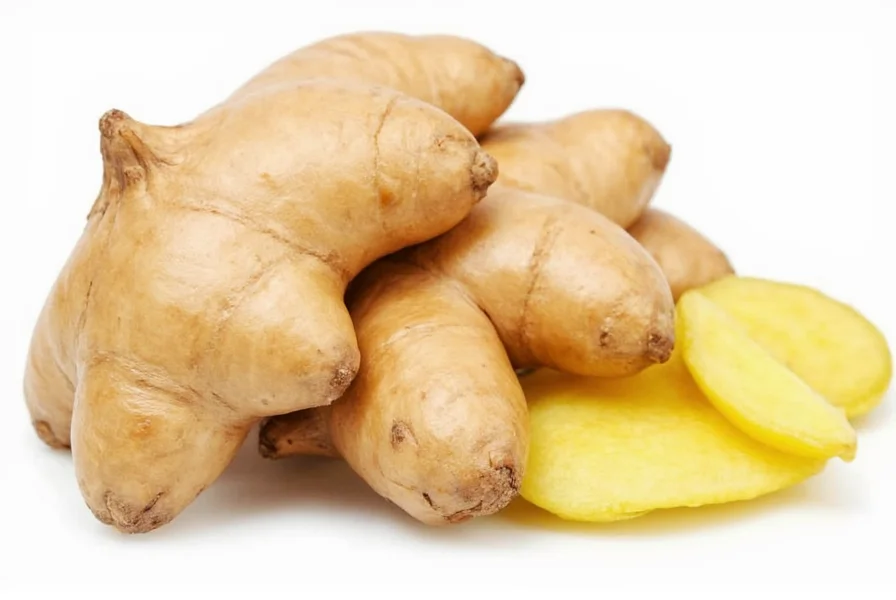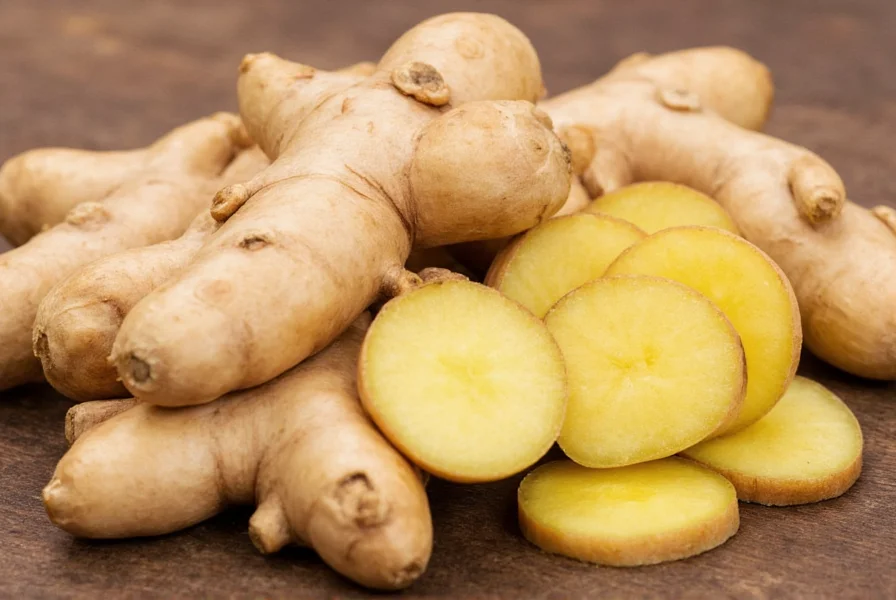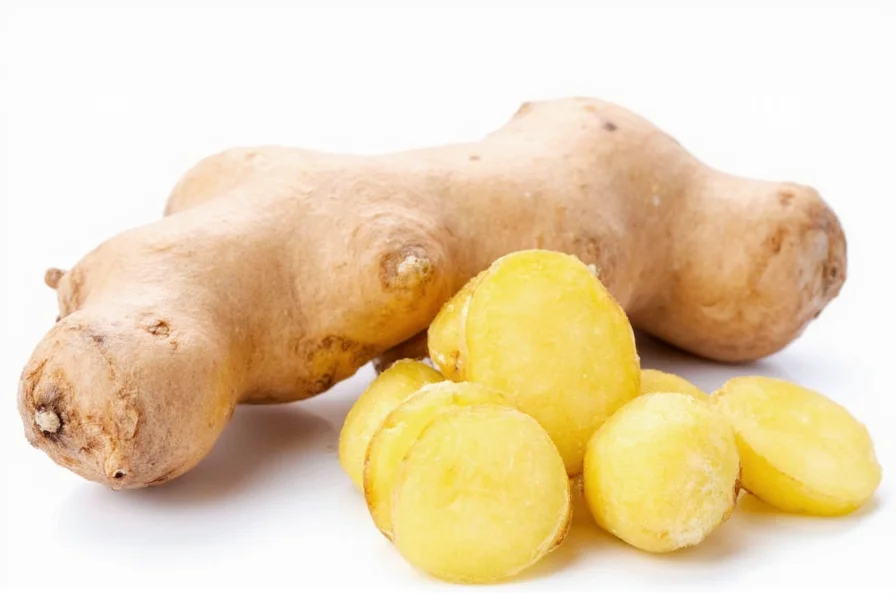The term ginger rhizome often causes confusion, as most people refer to it simply as “ginger root.” Understanding this botanical distinction is crucial for proper identification and usage. This underground stem structure contains higher concentrations of beneficial compounds compared to other plant parts, making it valuable in both culinary and traditional medicine applications.
Botanical Characteristics of Ginger Rhizome
Ginger (Zingiber officinale) belongs to the Zingiberaceae family, which includes turmeric and cardamom. The ginger rhizome represents the plant's horizontal underground stem that produces roots downward and shoots upward. Key botanical features include:
- Structure: Composed of nodes and internodes, with growth occurring at the terminal bud
- Color: Ranges from pale yellow to dark brown depending on variety and maturity
- Texture: Fibrous with a moist, fleshy interior when fresh
- Size: Typically 2-6 inches long in commercial varieties
Unlike true roots, ginger rhizome contains growth hormones that enable propagation. This characteristic makes it possible to grow new ginger plants by planting sections of the rhizome with at least one “eye” or growth bud.

Nutritional and Bioactive Compounds
The nutritional value of ginger rhizome extends beyond basic vitamins and minerals. Its therapeutic potential primarily comes from specialized compounds:
| Bioactive Compound | Concentration in Fresh Rhizome | Primary Benefits |
|---|---|---|
| Gingerols | 0.5-7.0% | Anti-inflammatory, antioxidant properties |
| Shogaols | 0.1-2.0% | Enhanced bioavailability, stronger pungency |
| Zingerone | Trace amounts | Antioxidant effects, milder flavor |
| Paradols | Formed during processing | Potential anticancer properties |
These compounds work synergistically, which is why whole ginger rhizome often provides more benefits than isolated extracts. The concentration of these compounds varies based on growing conditions, harvest time, and processing methods.
Scientifically Supported Health Benefits
Research on medicinal properties of ginger rhizome has expanded significantly in recent decades. Evidence-based benefits include:
Digestive Health
Multiple clinical studies confirm ginger rhizome's effectiveness for nausea relief. A 2022 meta-analysis published in Nutrients found that 1-1.5 grams of ginger rhizome daily significantly reduced pregnancy-related nausea and vomiting. The mechanism involves accelerated gastric emptying and modulation of serotonin receptors.
Inflammation Reduction
The anti-inflammatory effects of ginger rhizome have been documented in osteoarthritis research. A randomized controlled trial in Arthritis demonstrated that participants taking 500mg ginger extract twice daily reported 30% less pain after 12 weeks compared to placebo. The gingerols inhibit inflammatory pathways similar to non-steroidal anti-inflammatory drugs (NSAIDs), but with fewer side effects.
Metabolic Health
Emerging research suggests ginger rhizome may support metabolic health. A 2023 study in Complementary Therapies in Medicine showed that daily consumption of 2 grams of ginger powder improved insulin sensitivity in participants with type 2 diabetes. However, researchers emphasize that ginger should complement, not replace, standard diabetes management.

Traditional Uses vs. Scientific Evidence
Ginger rhizome has been used in traditional medicine systems for thousands of years. While many traditional applications align with modern research, some claims require careful evaluation:
- Traditional claim: Ginger cures colds
Scientific perspective: While ginger rhizome doesn't cure viral infections, its anti-inflammatory properties may alleviate cold symptoms like sore throat - Traditional claim: Ginger boosts immunity
Scientific perspective: Limited evidence suggests ginger may modulate immune response, but it doesn't “boost” immunity in the way often claimed - Traditional claim: Ginger aids weight loss
Scientific perspective: Some studies show modest metabolic effects, but ginger alone won't produce significant weight loss without dietary changes
When evaluating health benefits of ginger rhizome, it's essential to distinguish between traditional usage, preliminary research, and well-established clinical effects.
Practical Applications and Usage
Understanding how to properly select, store, and use fresh ginger rhizome maximizes its benefits:
Selecting Quality Ginger Rhizome
Look for firm, plump rhizomes with smooth skin and minimal wrinkles. Avoid pieces with soft spots or mold. The best ginger rhizome for cooking feels heavy for its size and has a spicy aroma when scratched.
Storage Methods
For short-term storage (up to 3 weeks), keep unpeeled ginger rhizome in the refrigerator's crisper drawer. For longer storage, freeze whole or sliced rhizome in an airtight container. Frozen ginger can be grated directly without thawing.
Culinary Preparation
The difference between ginger rhizome and ginger root matters in cooking. Young ginger rhizome has thinner skin and higher moisture content, making it ideal for pickling or raw applications. Mature rhizome has a stronger flavor suited for cooking. To maximize bioactive compounds, slice rather than mince, as increased surface area accelerates degradation of gingerols.
Growing Ginger Rhizome at Home
Cultivating ginger rhizome at home is feasible in various climates. Key considerations include:
- Soil requirements: Well-draining, nutrient-rich soil with pH 5.5-6.5
- Light conditions: Partial shade (2-5 hours of morning sun)
- Water needs: Consistent moisture without waterlogging
- Harvest timing: 8-10 months after planting for mature rhizomes
Start with organic ginger rhizome (conventional may be treated to prevent sprouting). Soak overnight, then plant with the eye bud facing up, 2-4 inches deep. In temperate climates, grow in containers that can be moved indoors during cold months.
Safety Considerations and Interactions
While generally safe, ginger rhizome consumption requires caution in specific situations:
- Blood thinning: Ginger may enhance effects of anticoagulants like warfarin
- Gallstones: May increase bile production, potentially problematic for those with gallstone disease
- Pregnancy: Moderate consumption is generally safe, but high doses should be avoided late in pregnancy
- Surgery: Discontinue use at least 2 weeks before scheduled surgery due to potential bleeding risk
The recommended daily limit for adults is 4 grams of raw ginger rhizome. Those with diabetes should monitor blood sugar closely, as ginger may enhance medication effects.
Conclusion
The ginger rhizome represents far more than just a kitchen staple. Its unique botanical structure houses valuable compounds with scientifically supported health applications. Understanding the distinction between ginger rhizome and true roots helps appreciate why this particular plant part delivers such distinctive benefits. When incorporating ginger rhizome into your routine, prioritize quality selection, appropriate usage, and awareness of potential interactions. As research continues to evolve, the scientific community gains deeper insights into optimizing the therapeutic potential of this remarkable botanical.
Frequently Asked Questions
Is ginger rhizome the same as ginger root?
No, ginger rhizome is technically not a root but an underground stem. While commonly called “ginger root,” true roots grow vertically downward, while rhizomes grow horizontally beneath the soil surface. This structural difference affects both the plant's growth pattern and the concentration of beneficial compounds.
What are the main health benefits of fresh ginger rhizome?
Research supports several health benefits of ginger rhizome, including relief from nausea (particularly morning sickness and chemotherapy-induced nausea), reduced muscle pain, decreased inflammation associated with osteoarthritis, and potential improvements in blood sugar regulation. The active compounds gingerols and shogaols are primarily responsible for these effects.
How much ginger rhizome should I consume daily?
For general health purposes, 1-3 grams of fresh ginger rhizome daily is considered safe for most adults. This equals approximately 1/4 to 3/4 teaspoon of grated ginger. Those using ginger for specific therapeutic purposes should consult healthcare providers, as higher doses up to 4 grams daily may be appropriate short-term but require medical supervision.
Can I grow ginger rhizome indoors?
Yes, ginger rhizome can be successfully grown indoors in containers. Choose a wide, shallow pot (12-16 inches deep) with good drainage. Use rich, well-draining potting mix and maintain consistent moisture without waterlogging. Place in indirect light with temperatures between 70-85°F (21-29°C). Indoor ginger typically takes 8-10 months to mature but can be harvested earlier for “green ginger.”
Does cooking affect the medicinal properties of ginger rhizome?
Cooking transforms but doesn't eliminate ginger's beneficial compounds. Heat converts gingerols to shogaols, which are more stable and potentially more bioavailable. While some compounds degrade with prolonged high heat, moderate cooking actually enhances certain therapeutic properties. For maximum benefit, add ginger rhizome toward the end of cooking rather than at the beginning.











 浙公网安备
33010002000092号
浙公网安备
33010002000092号 浙B2-20120091-4
浙B2-20120091-4